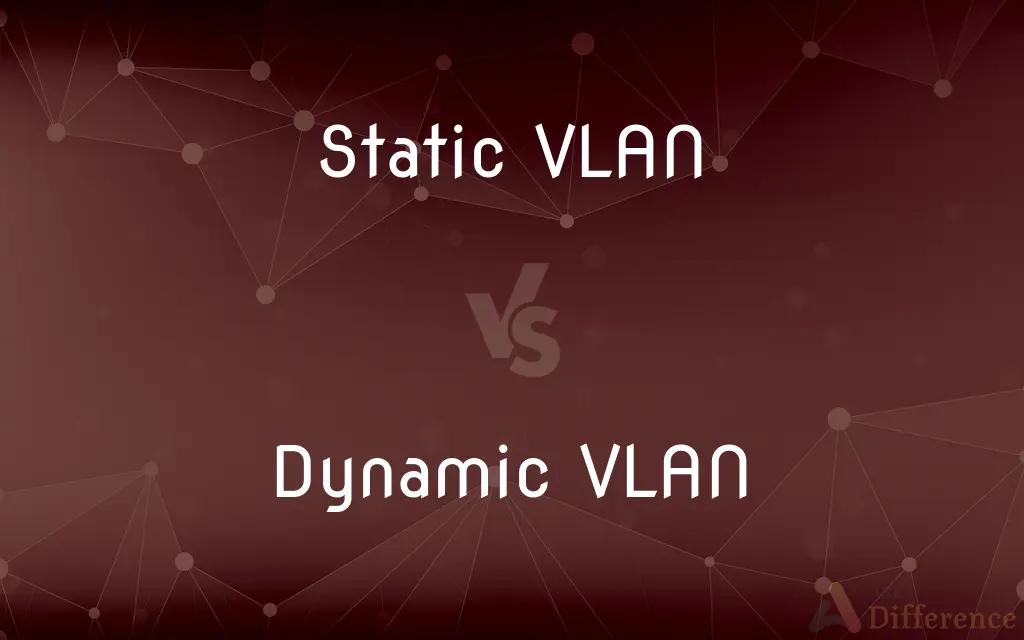Static VLAN vs. Dynamic VLAN — What's the Difference?
By Tayyaba Rehman — Published on November 12, 2023
Static VLAN: Assigns ports to VLANs manually. Dynamic VLAN: Assigns ports based on MAC addresses automatically.

Difference Between Static VLAN and Dynamic VLAN
Table of Contents
ADVERTISEMENT
Key Differences
In network configuration, a Static VLAN is one where network administrators assign individual switch ports to specific VLANs manually. This means that any device plugged into that port will be part of the assigned VLAN. On the contrary, a Dynamic VLAN relies on software to automatically assign switch ports to VLANs based on the MAC address of the device connected.
Considering the allocation method, Static VLANs are straightforward, ensuring a device remains within its designated VLAN as long as it's connected to the same port. Meanwhile, Dynamic VLANs provide flexibility as they allocate VLAN membership according to the device's MAC address, regardless of which port it's plugged into.
From a management perspective, Static VLANs can be simpler but might require more manual intervention, especially in networks with frequent changes. In contrast, Dynamic VLANs can adapt automatically to changes but might necessitate sophisticated software and infrastructure to manage the dynamic assignments effectively.
In terms of security, both Static VLAN and Dynamic VLAN have their own vulnerabilities and strengths. For instance, with a Static VLAN, if an unauthorized device connects to a preset port, it might gain access. However, with Dynamic VLANs, while the reliance on MAC addresses offers some flexibility, MAC spoofing can pose security risks.
Lastly, for operational efficiency, a Static VLAN might be preferred in stable environments with few changes, ensuring consistent performance without much oversight. Dynamic VLANs, however, shine in environments with frequent device movements, as they adjust VLAN assignments without manual intervention.
ADVERTISEMENT
Comparison Chart
Assignment Method
Manual port assignment.
Automatic based on MAC address.
Flexibility
Device remains in VLAN if connected to same port.
Device remains in VLAN regardless of port, based on MAC address.
Management
Simpler but requires manual changes.
Adapts automatically, needs advanced software.
Security Concerns
Unauthorized devices might access if plugged into preset port.
Vulnerable to MAC spoofing.
Operational Efficiency
Preferred in stable environments with fewer changes.
Ideal for environments with frequent device movements.
Compare with Definitions
Static VLAN
Fixed VLAN membership based on the specific switch port.
In our conference room, the Static VLAN ensures consistent network access for presentations.
Dynamic VLAN
Automatic VLAN configuration adapting to connected devices.
Using Dynamic VLAN, employees can move desks without network reconfigurations.
Static VLAN
Pre-determined port-based VLAN configuration.
The IT department uses a Static VLAN setup for the finance team's computers.
Dynamic VLAN
VLAN setup adjusting port assignments automatically.
The Dynamic VLAN streamlined the IT process during the office reshuffle.
Static VLAN
A VLAN with manually set port assignments.
The network administrator configured the Static VLAN for the office's main server.
Dynamic VLAN
VLAN that assigns devices based on their MAC addresses.
The Dynamic VLAN automatically assigned the new workstation to the appropriate network segment.
Static VLAN
A VLAN configuration needing manual adjustments for changes.
When a new printer was added, the Static VLAN settings were updated accordingly.
Dynamic VLAN
A network configuration that responds to device movements.
With Dynamic VLAN, changing rooms didn’t affect my computer's network access.
Static VLAN
VLAN setup where devices remain in the VLAN based on port connection.
With the Static VLAN setup, relocating a device means reconfiguring its port.
Dynamic VLAN
VLAN membership determined by the device's unique MAC address.
The company's BYOD policy was easier to manage with Dynamic VLAN configurations.
Common Curiosities
Which VLAN type might be more vulnerable to unauthorized access via port connections?
Static VLAN might be more vulnerable if unauthorized devices connect to pre-set ports.
What's the primary method of assignment in Static VLAN?
Static VLAN assigns devices based on manual port configurations.
Which VLAN type might be preferred in a stable office environment?
A Static VLAN might be preferred due to its consistency and less frequent changes.
How does Dynamic VLAN determine membership?
Dynamic VLAN assigns membership based on a device's MAC address.
Are manual interventions frequent in Dynamic VLAN?
No, Dynamic VLAN adjusts automatically, reducing the need for manual changes.
Can MAC spoofing affect Dynamic VLAN?
Yes, Dynamic VLAN can be vulnerable to MAC spoofing since it relies on MAC addresses.
In which scenario would Dynamic VLAN be more beneficial?
Dynamic VLAN is ideal for environments with frequent device relocations or movements.
Does Static VLAN require frequent manual configuration?
Yes, Static VLAN requires manual adjustments when there are changes in device or port assignments.
Which VLAN type may necessitate advanced software for management?
Dynamic VLAN might require sophisticated software for managing automatic assignments.
What happens when a new device is added in Dynamic VLAN?
In Dynamic VLAN, the new device is automatically assigned to a VLAN based on its MAC address.
Can a device in Static VLAN change its VLAN by switching ports?
In a Static VLAN, the device changes its VLAN if moved to a different pre-configured port.
Can a device retain its VLAN membership in Dynamic VLAN even after changing ports?
Yes, in Dynamic VLAN, a device retains its membership based on its MAC address, irrespective of the port.
Which VLAN type provides more operational efficiency in dynamic environments?
Dynamic VLAN offers more operational efficiency in environments with frequent changes or movements.
How does Dynamic VLAN maintain flexibility?
Dynamic VLAN automatically adjusts based on the MAC addresses of connected devices.
Is Static VLAN more predictable in terms of device network access?
Yes, Static VLAN offers predictability as devices remain in their VLAN based on port connection.
Share Your Discovery

Previous Comparison
Valence Electrons vs. Free Electrons
Next Comparison
HB Pencil vs. F PencilAuthor Spotlight
Written by
Tayyaba RehmanTayyaba Rehman is a distinguished writer, currently serving as a primary contributor to askdifference.com. As a researcher in semantics and etymology, Tayyaba's passion for the complexity of languages and their distinctions has found a perfect home on the platform. Tayyaba delves into the intricacies of language, distinguishing between commonly confused words and phrases, thereby providing clarity for readers worldwide.
















































